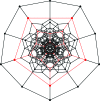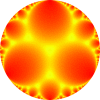Algorithmic design of self-assembling structures
- PMID: 19541660
- PMCID: PMC2701027
- DOI: 10.1073/pnas.0901636106
Algorithmic design of self-assembling structures
Abstract
We study inverse statistical mechanics: how can one design a potential function so as to produce a specified ground state? In this article, we show that unexpectedly simple potential functions suffice for certain symmetrical configurations, and we apply techniques from coding and information theory to provide mathematical proof that the ground state has been achieved. These potential functions are required to be decreasing and convex, which rules out the use of potential wells. Furthermore, we give an algorithm for constructing a potential function with a desired ground state.
Conflict of interest statement
The authors declare no conflict of interest.
Figures





Similar articles
-
Unusual ground states via monotonic convex pair potentials.J Chem Phys. 2011 Apr 28;134(16):164105. doi: 10.1063/1.3576141. J Chem Phys. 2011. PMID: 21528948
-
Probing the limitations of isotropic pair potentials to produce ground-state structural extremes via inverse statistical mechanics.Phys Rev E Stat Nonlin Soft Matter Phys. 2013 Oct;88(4):042309. doi: 10.1103/PhysRevE.88.042309. Epub 2013 Oct 23. Phys Rev E Stat Nonlin Soft Matter Phys. 2013. PMID: 24229174
-
Communication: Designed diamond ground state via optimized isotropic monotonic pair potentials.J Chem Phys. 2013 Feb 14;138(6):061101. doi: 10.1063/1.4790634. J Chem Phys. 2013. PMID: 23425451
-
Self-assembling organic nanotubes with precisely defined, sub-nanometer pores: formation and mass transport characteristics.Acc Chem Res. 2013 Dec 17;46(12):2856-66. doi: 10.1021/ar400030e. Epub 2013 Apr 18. Acc Chem Res. 2013. PMID: 23597055 Review.
-
Hybrid schemes based on quantum mechanics/molecular mechanics simulations goals to success, problems, and perspectives.Adv Protein Chem Struct Biol. 2011;85:81-142. doi: 10.1016/B978-0-12-386485-7.00003-X. Adv Protein Chem Struct Biol. 2011. PMID: 21920322 Review.
Cited by
-
New family of tilings of three-dimensional Euclidean space by tetrahedra and octahedra.Proc Natl Acad Sci U S A. 2011 Jul 5;108(27):11009-12. doi: 10.1073/pnas.1105594108. Epub 2011 Jun 20. Proc Natl Acad Sci U S A. 2011. PMID: 21690370 Free PMC article.
-
Algorithmic design of self-folding polyhedra.Proc Natl Acad Sci U S A. 2011 Dec 13;108(50):19885-90. doi: 10.1073/pnas.1110857108. Epub 2011 Dec 2. Proc Natl Acad Sci U S A. 2011. PMID: 22139373 Free PMC article.
-
Effective potentials induced by self-assembly of patchy particles.Soft Matter. 2017 Sep 20;13(36):6051-6058. doi: 10.1039/c7sm01293d. Soft Matter. 2017. PMID: 28829478 Free PMC article.
-
A minimal model of predator-swarm interactions.J R Soc Interface. 2014 Mar 5;11(94):20131208. doi: 10.1098/rsif.2013.1208. Print 2014 May 6. J R Soc Interface. 2014. PMID: 24598204 Free PMC article.
-
Spherical-Symmetry and Spin Effects on the Uncertainty Measures of Multidimensional Quantum Systems with Central Potentials.Entropy (Basel). 2021 May 14;23(5):607. doi: 10.3390/e23050607. Entropy (Basel). 2021. PMID: 34068983 Free PMC article. Review.
References
-
- Torquato S. Inverse optimization techniques for targeted self-assembly. Soft Matter. 2009;5:1157–1173. arXiv:0811.0040.
-
- Rechtsman M, Stillinger FH, Torquato S. Optimized interactions for targeted self-assembly: application to honeycomb lattice. Phys Rev Lett. 2005;95:228301. arXiv:cond-mat/0508495. - PubMed
-
- Rechtsman M, Stillinger FH, Torquato S. Designed isotropic potentials via inverse methods for self-assembly. Phys Rev E. 2006;73:011406. arXiv:cond-mat/0603415. - PubMed
-
- Rechtsman M, Stillinger FH, Torquato S. Self-assembly of the simple cubic lattice via an isotropic potential. Phys Rev E. 2006;74:021404. arXiv:cond-mat/0606674. - PubMed
-
- Rechtsman M, Stillinger FH, Torquato S. Synthetic diamond and Wurtzite structures self-assemble with isotropic pair interactions. Phys Rev E. 2007;75:031403. arXiv:0709.3807. - PubMed
LinkOut - more resources
Full Text Sources

